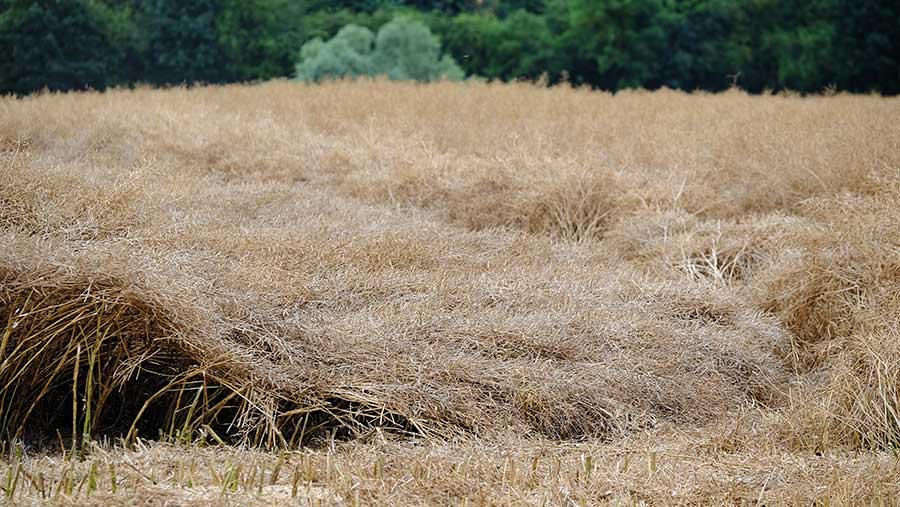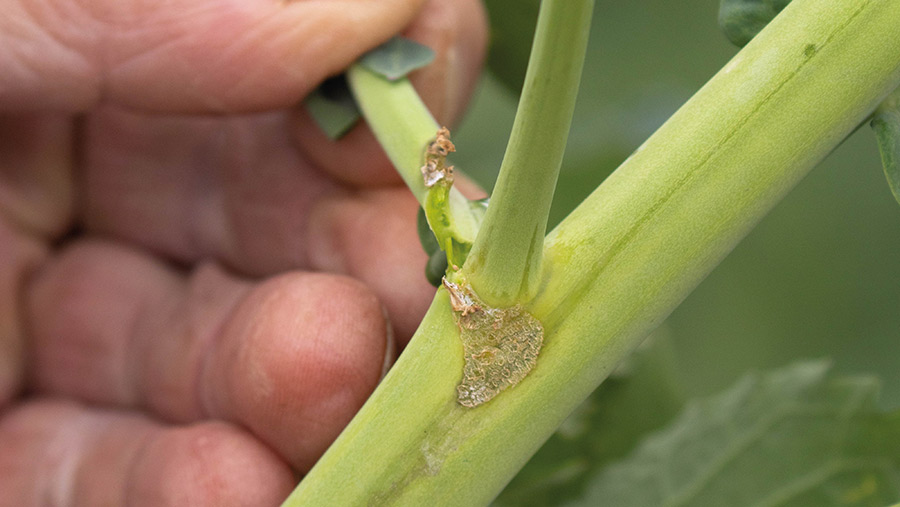Trial reveals true impact of cabbage stem flea beetle on lodging in OSR
 © Tim Scrivener
© Tim Scrivener Oilseed rape growers with crops infested with cabbage stem flea beetle (CSFB) larvae are being advised to consider using plant growth regulators to reduce crop height, as new trial data shows how infected crops can suffer from reduced stem strength and increased lodging risk.
The investigation, run by crop consultant Adas, highlighted that even healthy crops which exhibit normal outward development with little flea beetle damage can be prone to lodging.
Low-level flea beetle damage was found to reduce stem strength by nearly 30%, which ultimately led to a 23% higher lodging risk.
See also: First-ever sclerotinia-tolerant OSR could help cut costs
The cost of lodging in oilseed rape
Lodging can result in significant revenue losses, with compressed canopies reducing photosynthesis rates, which consequently lowers yield.
Each year, a significant area of oilseed rape in the UK lodges, and this is often missed or not identified until harvest, explains Pete Berry, head of crop physiology at Adas.
A study examining the impact of lodging on yield loss found that severe lodging at 90deg during early flowering reduced yield by nearly 50% and oil content by 8%.
Trial plots were set up to mimic the natural lodging process at four crop development stages (early flower, mid-flower, start of seed fill and mid-seed fill) and three different angles – 22.5deg, 45deg and 90deg.
Late leaning was shown to have substantial effects on yield, with a 22.5deg lean at mid-seed fill causing a yield loss of 16%, despite this often considered to have no detrimental yield effect.
During lodging, the canopy compresses, so it is no longer in a favourable orientation for capturing light. Seed fill efficiency falls and pods abort, causing yields to tumble.
Percentage yield loss from lodging at various development stages in OSR |
|||
|
Development stage |
Angle of lodging |
||
|
|
22.5deg |
45deg |
90deg |
|
Early flower |
7% |
19% |
48% |
|
Mid-flower |
7% |
21% |
44% |
|
Start of seed fill |
9% |
22% |
45% |
|
Mid-seed fill |
16% |
22% |
38% |
Further costs of lodging also include uneven ripening, additional time spent combining and expenditure on drying and add-mixture.
“Lodging costs UK growers about £47m-£120m in a best/worst-case scenario. This is compared to phoma, which costs £60m-£80m, and light leaf spot, which costs £80m-£160m,” says Pete Berry, head of crop physiology at Adas.
Internal flea beetle damage
Fran Pickering, entomologist at the group, explains how the trial set out to examine CSFB and its implications on stem strength and lodging risk in OSR crops.
A total of 50 plants were collected from two sites in May at the end of flowering, where the diameter and breaking strength of each stem was recorded.
The internal flea beetle damage of the crops were then scored on a scale from one to five, where one was minimal damage and five was severe.
“Most stems experienced minimal to moderate damage, with a score rating of either one, two or three,” she says.
The trial found that the thicker the stem, the greater the stem strength, and that for any given stem diameter, the greater the area of flea beetle damage, the weaker the stem became.
It was also discovered that larvae cause mining and browning at the stem base, which restricts nutrient and water uptake in the plant, contributing to the development of both a hollower and weaker stem and, consequently, a greater likelihood of lodging.
“A reduction in stem strength significantly increases lodging risk,” reports Ms Pickering.

© Tim Scrivener
Even low-damage crops, with 6-25% of their internal area damaged, experienced a lodging risk increase from one in 10 to one in three. This was due to flea beetle damage reducing stem strength by 29%, despite crops expressing normal outward development.
This highlighted the significance of lodging in OSR, with many crops appearing visually fine, but actually suffering from significant stem weakness.
In fact, it was only “severely” damaged crops, which had between 76 and 100% of their internal crop area damaged, that were identifiable externally.
Internal flea beetle damage score |
||
|
Damage group |
Rating |
% of internal damaged area |
|
Minimal |
1 |
<5% |
|
Low |
2 |
6-25% |
|
Moderate |
3 |
26-50% |
|
High |
4 |
51-75% |
|
Severe |
5 |
76-100% |
Growing advice
Ms Pickering, therefore, recommends reducing crop height to counteract lodging risk as its impact in OSR is often underestimated and usually unseen until harvest.
To help counteract stem weakness, she offers the following advice:
- Apply a plant growth regulator (PGR) at the beginning of stem extension to reduce crop height, by about 10%.
- If the green area index is greater than 1.5, it is suggested to delay or reduce the first spring nitrogen split.
- Consider lower plant populations when establishing the crop, as reduced plants per area allows the development of thicker and stronger stems.

